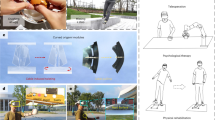Abstract
Achieving high stiffness, low inertia and friction is a big challenge in the design of a haptic device. Admittance display is a common solution to obtain high stiffness but is difficult to achieve low inertia and friction. We describe a new concept of co-actuation to overcome this difficulty. The co-actuation approach disconnects the actuators and joints of a haptic device, making the two components work cooperatively according to characteristics of simulated environment. In free space, the joints are tracked and followed by the actuators. Users can move the joints freely without feeling resistance from the actuators. In constraint space, physical constraints driven by the actuators apply impedance to the joints. By producing a direct physical contact between the joints and the physical constraints, users can feel a hard virtual surface. The paper describes the mechanical and control design and implementation of a one degree-of-freedom (DOF) co-actuation module. Stiffness of 40 N/mm and friction force of less than 0.3 N was achieved on the module. By effectively reducing inertia and friction, the proposed approach demonstrates its potential advantage over conventional admittance displays. The co-actuation approach can be applied to multi-DOF haptic devices to achieve high stiffness, low inertia and friction.
Access this chapter
Tax calculation will be finalised at checkout
Purchases are for personal use only
Similar content being viewed by others
References
Massie, T., Salisbury, J.: The PHANTOM haptic interface: a device for probing virtual objects. In: ASME Winter Annual Meeting, Symposium on Haptic Interfaces for Virtual Environment and Teleoperator Systems, vol. DSC 55, Chicago, IL, pp. 295–302 (1994)
Salisbury, K., Eberman, B., Levin, M., Townsend, W.: The design and control of an experimental whole-arm manipulator. In: The Fifth International Symposium on Robotics Research, pp. 233–241 (1990)
Van der Linde, R., Lammertse, P., Frederiksen, E., Ruiter, B.: The haptic master, a new high-performance haptic interface. In: Proceedings of Euro-Haptics, Edinburgh, U.K. (2002)
Faulring, E., Colgate, J., Peshkin, M.: The cobotic hand controller: design, control and performance of a novel haptic display. Int. J. Robot. Res. 25(11), 1099–1119 (2005)
Arata, J., Kondo, H., Ikedo, N., Fujimoto, H.: Haptic device using a newly developed redundant parallel mechanism. IEEE Trans. Robot. 27(2), 201–214 (2011)
Wang, D., Zhang, Y., Hou, J., Wang, Y., Lv, P., Chen, Y., Zhao, H.: iDental: a haptic-based dental simulator and its preliminary evaluation. IEEE Trans. Haptics 5(4), 332–343 (2012)
Hungr, N., Roger, B., Hodgson, A.J., Plaskos, C.: Dynamic physical constraints: emulating hard surfaces with high realism. IEEE Trans. Haptics 5(1), 48–57 (2012)
Colgate, J.E., Schenkel, G.: Passivity of a class of sampled data systems: application to haptic interfaces. In: Proceedings of the American Control Conference, pp. 3236–3240 (1994)
Abbott, J.J., Okamura, A.M.: Effects of position quantization and sampling rate on virtual wall passivity. IEEE Trans. Robot. 21(5), 952–964 (2005)
Diolaiti, N., Niemeyer, G., Barbagli, F., Salisbury, J.K.: Stability of haptic rendering: discretization, quantization, time delay, and coulomb effects. IEEE Trans. Robot. 22(2), 256–268 (2006)
Mahvash, M., Hayward, V.: High fidelity passive force reflecting virtual environments. IEEE Trans. Robot. 21(1), 38–46 (2005)
Zinn, M., Khatib, O., Roth, B., Salisbury, J.K.: Large workspace haptic devices: a new actuation approach. In: Symposium on Haptic Interfaces for Virtual Environment and Teleoperator Systems, pp. 185–192 (2008)
Cho, C., Song, J.-B., Kim, M.: Energy-based control of a haptic device using brakes. IEEE Trans. Syst. Man Cybern. Part B Cybern. 37(2), 341–349 (2007)
Conti, F., Khatib, O., Baur, C.: A hybrid actuation approach for haptic devices. In: World Haptics 2007, pp. 367–372 (2007)
An, J., Kwon, D.S.: Stability and performance of haptic interfaces with active/passive actuators theory and experiments. Int. J. Robot. Res. 25(11), 1121–1136 (2006)
Kwon, T.B., Song, J.B.: Force display using a hybrid haptic device composed of motors and brakes. Mechatronics 16, 249–257 (2006)
Swanson, D.K., Book, W.J.: Path-following control for dissipative passive haptic displays. In: Proceedings of the 11th Symposium on Haptic Interfaces for Virtual Environment and Teleoperator Systems, pp. 101–108, March 2003
Gosline, A.H.C., Hayward, V.: Eddy current brakes for haptic interfaces: design, identification, and control. IEEE/ASME Trans. Mechatron. 13(6), 669–677 (2008)
Weir, D.W., Colgate, J.E., Peshkin, M.A.: Measuring and increasing Z-width with active electrical damping. In: Proceedings of the Symposium on Haptic Interfaces for Virtual Environment and Teleoperator Systems, pp. 169–175 (2008)
Lawrence, D.A., Chapel, J.D.: Performance trade-offs for hand controller design. In: Proceedings of the IEEE International Conference on Robotics and Automation, vol. 4, pp. 3211–3216, May 1994
Author information
Authors and Affiliations
Corresponding authors
Editor information
Editors and Affiliations
Rights and permissions
Copyright information
© 2016 Springer International Publishing Switzerland
About this paper
Cite this paper
Song, J., Zhang, Y., Zhang, H., Wang, D. (2016). Co-actuation: Achieve High Stiffness and Low Inertia in Force Feedback Device. In: Bello, F., Kajimoto, H., Visell, Y. (eds) Haptics: Perception, Devices, Control, and Applications. EuroHaptics 2016. Lecture Notes in Computer Science(), vol 9774. Springer, Cham. https://doi.org/10.1007/978-3-319-42321-0_21
Download citation
DOI: https://doi.org/10.1007/978-3-319-42321-0_21
Published:
Publisher Name: Springer, Cham
Print ISBN: 978-3-319-42320-3
Online ISBN: 978-3-319-42321-0
eBook Packages: Computer ScienceComputer Science (R0)




